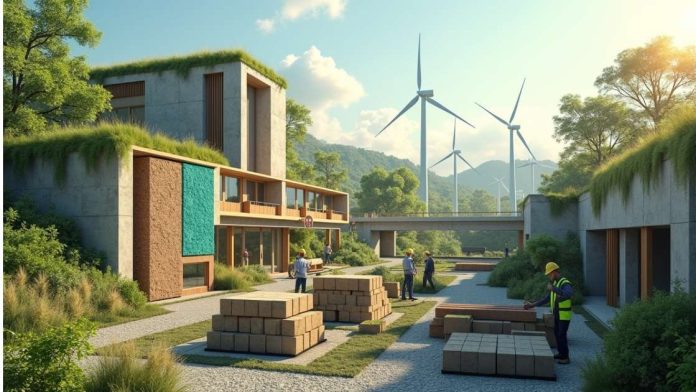Imagine a world where the buildings we live in, the roads we travel on, and even the furniture in our homes actually pull carbon dioxide out of the atmosphere instead of adding to it. Sounds futuristic, right?
Welcome to the world of carbon-negative materials—a revolutionary approach to construction and manufacturing that doesn’t just aim for “sustainable” or “net-zero,” but goes a step further to reverse environmental damage.
As climate concerns grow, and with industries like construction and manufacturing responsible for a significant portion of global emissions, this innovation offers a powerful new direction. So, let’s dive into how carbon-negative materials work, what they are made of, and how we can adopt them in real life to help the planet while still building the world we need.
What Are Carbon-Negative Materials?
At their core, carbon-negative materials remove more carbon dioxide (CO₂) from the atmosphere than they emit during production and use. This could happen in several ways:
-
Sequestering CO₂ during production (e.g., using carbon captured from the air)
-
Using naturally carbon-absorbing ingredients like biochar or algae
-
Locking away carbon for decades or centuries within durable products
The key here is that these materials don’t just aim for neutrality—they actively help clean the air.
Examples of Game-Changing Carbon-Negative Materials
Here are some materials already transforming how we think about sustainable building and manufacturing:
1. Hempcrete
A mix of hemp hurds (the woody core of the hemp plant), lime, and water, hempcrete is light, insulating, and naturally absorbs carbon as it cures. It’s also biodegradable and non-toxic.
2. Biochar-Enhanced Concrete
Biochar, a charcoal-like substance made by heating organic material without oxygen, is used as a concrete additive. It stores carbon for hundreds of years and improves soil and material strength.
3. Carbon-Cured Concrete
Companies like CarbonCure inject captured CO₂ into concrete during mixing. The CO₂ chemically reacts and becomes permanently mineralized, strengthening the concrete while reducing its carbon footprint.
4. Mycelium-Based Insulation
Made from fungi roots, mycelium materials grow in molds and offer excellent insulation properties. They’re fully compostable and absorb carbon during production.
5. Algae-Based Plastics and Foams
Algae grow rapidly and absorb carbon, making them a sustainable feedstock for creating biodegradable foams and plastics used in packaging and furniture.
Why Carbon-Negative Materials Matter (More Than Ever)
The construction sector alone is responsible for nearly 40% of global CO₂ emissions. And with urban populations growing, the demand for infrastructure is only increasing.
By switching to carbon-negative options, we can:
-
Turn buildings into carbon sinks
-
Reduce reliance on fossil-fuel-intensive materials
-
Promote circular economy principles
-
Support regenerative agriculture (since many materials use crop byproducts)
This isn’t just environmental—it’s economic and social too. Green building materials can open doors for new jobs, healthier homes, and more resilient communities.
Actionable Tips: How You Can Support and Use Carbon-Negative Materials
1. Ask for Greener Building Options
Whether renovating or building, talk to your contractor about carbon-negative alternatives. Many are cost-competitive and available.
2. Support Companies Using Bio-Based Materials
From furniture to fashion, many brands now offer products made with mycelium, hemp, or algae. Make eco-conscious choices when shopping.
3. Educate Yourself and Others
Knowledge is power. Share articles, attend green building webinars, and advocate for sustainable material use in your community.
4. Encourage Policy Changes
Support local or national green building codes that incentivize carbon-negative materials. Policy can help scale adoption faster.
5. Invest in Regenerative Projects
If you have the means, invest in startups or community initiatives focused on sustainable construction and carbon capture.
Frequently Asked Questions (FAQs)
1. Are carbon-negative materials widely available?
Not yet—but they’re gaining ground. Many are currently in pilot or early market phases, but with demand and awareness growing, wider adoption is on the horizon.
2. Do these materials really last as long as conventional ones?
Yes. In many cases, carbon-negative materials are just as durable—if not more so. For example, hempcrete can last over 100 years with proper maintenance.
3. Are carbon-negative materials expensive?
Costs vary, but many options are becoming increasingly affordable. Long-term savings (like energy efficiency and low maintenance) often offset initial expenses.
4. Can I use these materials for small-scale DIY projects?
Absolutely! Products like biochar bricks, algae-based packing, and mycelium furniture are ideal for eco-conscious homeowners and DIY enthusiasts.
5. How can I tell if a product is truly carbon-negative?
Look for verified carbon lifecycle assessments (LCAs) or certifications from reputable green organizations. Avoid greenwashing by doing a bit of research on the brand’s sustainability claims.
Conclusion
The journey to reversing climate change isn’t just about cutting emissions—it’s about finding creative ways to draw carbon back down and use it in meaningful, lasting ways. Carbon-negative materials give us that chance. They show that what we build today doesn’t have to be part of the problem—it can be part of the solution.
Whether you’re a builder, a consumer, a designer, or just a curious reader, your choices matter. Every eco-friendly product you support sends a message: We want a healthier planet, and we’re willing to innovate to get there.
We’d love to hear from you! How do you manage your time when trying to stay informed and make sustainable lifestyle choices?
Share your tips, strategies, or even struggles in the comments. Let’s build a supportive community that’s just as strong and enduring as the materials shaping our greener future.

